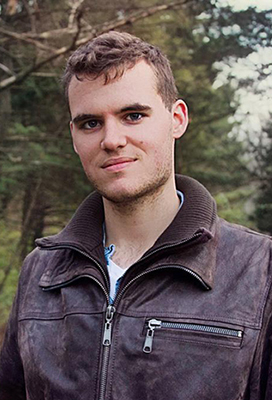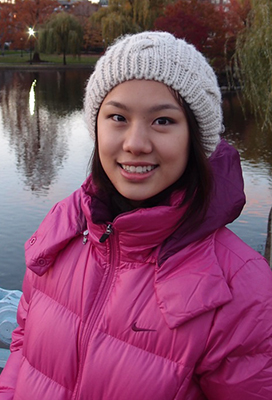The Illinois Biomathematics Research Experience Program is a year-long research experience in mathematical biology. Despite the strong demand for students that are trained in biomathematics, undergraduate mathematics and biology majors still proceed largely along parallel isolated tracks, with many biology students acquiring very few mathematical skills and concepts, while many mathematics students remain relatively uninformed about biology. The Illinois Biomathematics Research Program brings mathematics and biology students together under joint mentorship by biologists and mathematicians. Our goal is to contribute a generation of scientists and mathematicians to meet the new challenges at the interface between these two disciplines. Additional information about the program can be found here: http://www.math.uiuc.edu/biomath/
The 2013 National Science Foundation funded fellows are working on the three projects under the guidance of faculty from the Departments of Mathematics and Animal Biology.
 Gene Regulation and Limb Development
Gene Regulation and Limb Development
Kari Kosog (Integrative Biology), Rachel Poe (Mathematics), Dr. Zoi Rapti (Mathematics), Dr. Karen Sears (Animal Biology)
Hi! My name is Rachel Poe, and I’m a sophomore researching mammalian limb development with Dr. Zoi Rapti and Dr. Karen Sears. I’m a mathematics major and a computer science and biology enthusiast. Needless to say, I am really excited to be a part of the U of I BioMath team this year. Before I came to school, I was convinced that I had to choose just one subject to study, and was disappointed that I wouldn’t be able to use multiple areas of interest for one purpose. But I quickly discovered that this was not the case — and now I get to use differential equations to model gene interactions in the process of limb growth! I can’t say that the project is without challenges, and I still have a lot to learn. One of the challenges for me has been connecting the more advanced biological concepts with the math models. Although I really enjoy biology, I don’t have as strong a background in it as I do math. But I’m excited by challenges and am always looking for something new to learn. That’s one of the reasons I’m excited to be working on this project — I’m learning so much along the way, and I know I’ll always have more to learn! I look forward to spending my summer in full-time research and exploring all the things I have yet to discover.
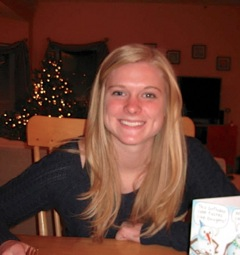 Hello there, my name is Kari Kosog, and I am currently a sophomore majoring in Integrative Biology and German. I took the Biomath class because it sounded interesting and like a fresh way to look at things. I really enjoyed it and decided to apply for the internship, and I am now working on a project under the supervision of Dr. Karen Sears and Dr. Zoi Rapti looking at the gene regulatory network in limb development. One of my favorite things about this project is that mapping gene networks mathematically is a relatively new field. I will be working in the lab with Dr. Sears to evaluate the gene networks. The math portion of the project is definitely new to me. I have a strong math background but have never tried to model anything. This is my first major project in a lab, and I am so excited to gain experience, learn from our advisors, and begin a life of scientific discovery!
Hello there, my name is Kari Kosog, and I am currently a sophomore majoring in Integrative Biology and German. I took the Biomath class because it sounded interesting and like a fresh way to look at things. I really enjoyed it and decided to apply for the internship, and I am now working on a project under the supervision of Dr. Karen Sears and Dr. Zoi Rapti looking at the gene regulatory network in limb development. One of my favorite things about this project is that mapping gene networks mathematically is a relatively new field. I will be working in the lab with Dr. Sears to evaluate the gene networks. The math portion of the project is definitely new to me. I have a strong math background but have never tried to model anything. This is my first major project in a lab, and I am so excited to gain experience, learn from our advisors, and begin a life of scientific discovery!
We will specifically be looking at the feedback loops of the growth factors including sonic hedgehog, Gremlin 1, fibroblast growth factor (FGF), and Bone Morphogenic Protein 4 (BMP4). We will be comparing the differences between chicken, bats and opossums. The figure (Zellner 2009) shows an example of the network we will be working with. It is also an example of how the genes Sonic Hedgehog, Gremlin 1, BMP4, and FGF work together in regulatory loops. By creating a differential equation to map the feedback and regulatory loops, we can predict the effect of each gene on the system.
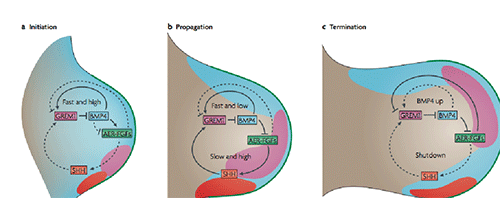 Figure from:
Figure from:
Zeller, R., Lopez-Rios, J., Zuniga, A. December 2009.Vertebrate limb bud development: moving towards integrative analysis of organogenesis. Nature Reviews, 10. 845-858.
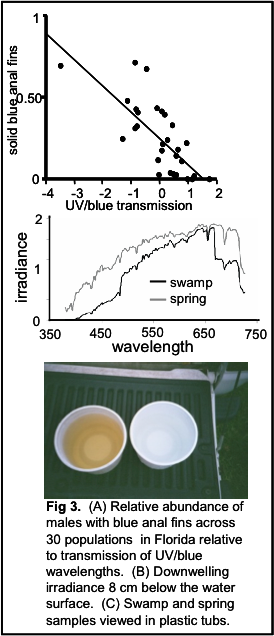 Visual Ecology of the Two Cone Visual System of Largemouth Bass
Visual Ecology of the Two Cone Visual System of Largemouth Bass
Shannon Stanis (Integrative Biology), Nick Sutton (Integrative Biology), Zach Turner (Mathematics), Dr. Lee DeVille (Mathematics), Dr. Becky Fuller (Animal Biology)
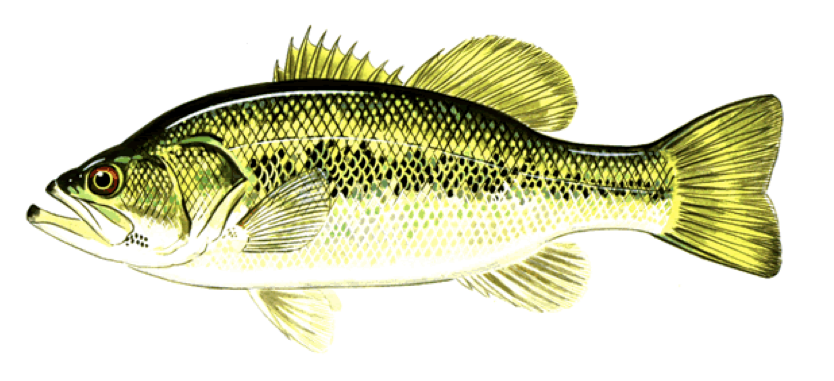 Our group is working hard on developing both a theoretical and a functional mathematical model of the two cone visual system of largemouth bass (Micropterus salmoides) to better understand the predatory behavior of these fish in varying water environments. Now, without further ado, let’s introduce the undergraduate researchers:
Our group is working hard on developing both a theoretical and a functional mathematical model of the two cone visual system of largemouth bass (Micropterus salmoides) to better understand the predatory behavior of these fish in varying water environments. Now, without further ado, let’s introduce the undergraduate researchers:
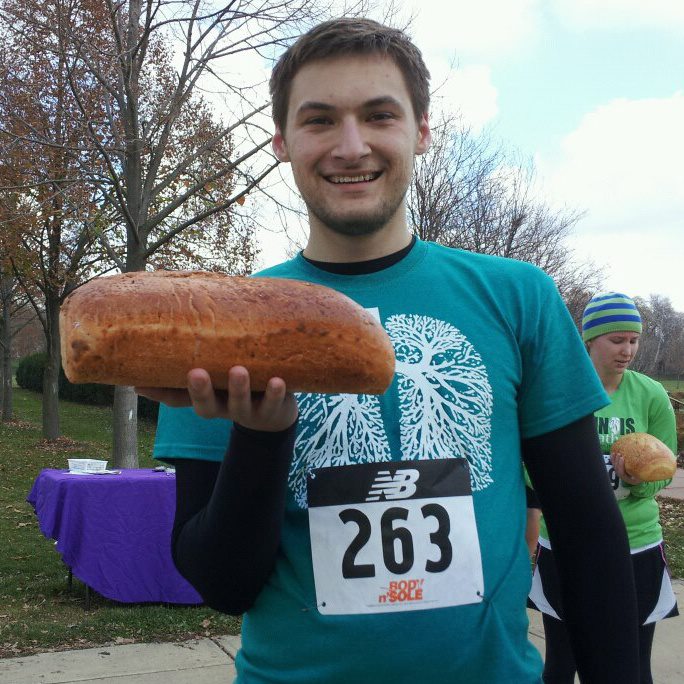 Hi everyone, my name is Zach Turner and I am a sophomore studying mathematics. Most of my work on this project thus far has been extracting equations from the paper we are studying and then converting that into a workable code that we can manipulate with various data inputs. To be honest, I actually have really enjoyed doing that! It’s frustrating working with computers when things aren’t going your way, but I love the satisfaction when it’s finally working. My biggest struggle is coping with my extreme lack of biological knowledge, but luckily my fellow group members Nick and Shannon are more than capable of explaining all the science to me. Currently our project is rather preliminary but I am very excited to see how far we can expand it in the future!
Hi everyone, my name is Zach Turner and I am a sophomore studying mathematics. Most of my work on this project thus far has been extracting equations from the paper we are studying and then converting that into a workable code that we can manipulate with various data inputs. To be honest, I actually have really enjoyed doing that! It’s frustrating working with computers when things aren’t going your way, but I love the satisfaction when it’s finally working. My biggest struggle is coping with my extreme lack of biological knowledge, but luckily my fellow group members Nick and Shannon are more than capable of explaining all the science to me. Currently our project is rather preliminary but I am very excited to see how far we can expand it in the future!
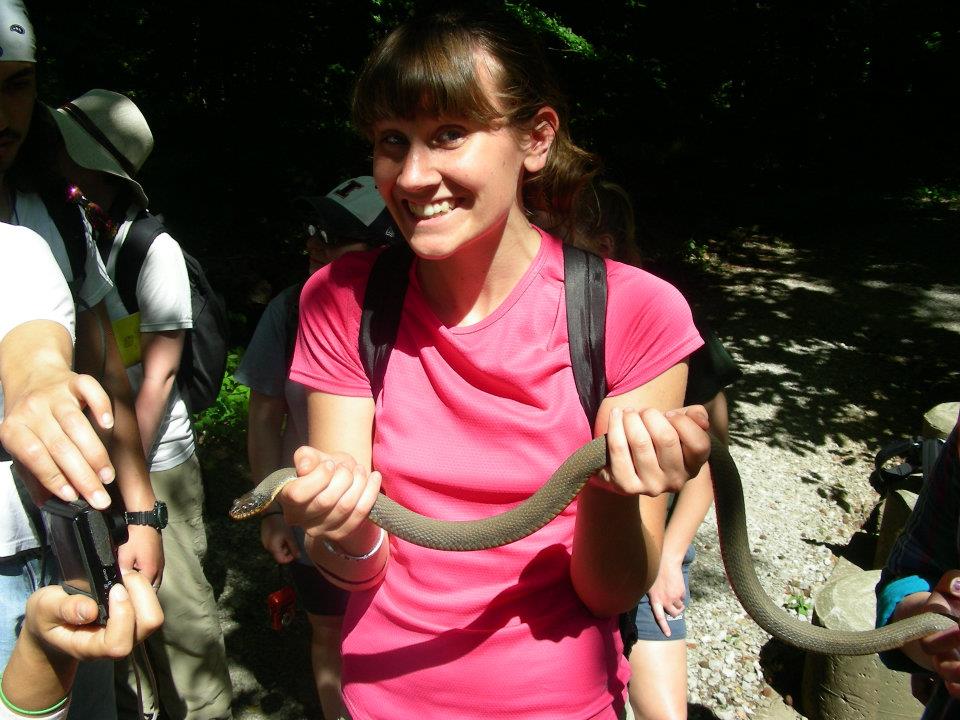 I’m Shannon Stanis, a senior double majoring in Integrative Biology and Psychology. I have been working in Becky Fuller’s lab for three years researching the visual system of killifish and now I am really excited to work with Zach and Nick to research their predator, the largemouth bass. Biomath is a perfect way to satisfy my scientific curiosity. We have been reading papers and sitting down together to talk through figuring out exactly what we want to know and how we are going to figure it out. I’m looking forward to lots of time with Zach, Nick, and, of course, the bass, to complete our behavioral assays this summer and integrate it into our model. We have a great team and I’m sure we will find some fascinating results!
I’m Shannon Stanis, a senior double majoring in Integrative Biology and Psychology. I have been working in Becky Fuller’s lab for three years researching the visual system of killifish and now I am really excited to work with Zach and Nick to research their predator, the largemouth bass. Biomath is a perfect way to satisfy my scientific curiosity. We have been reading papers and sitting down together to talk through figuring out exactly what we want to know and how we are going to figure it out. I’m looking forward to lots of time with Zach, Nick, and, of course, the bass, to complete our behavioral assays this summer and integrate it into our model. We have a great team and I’m sure we will find some fascinating results!
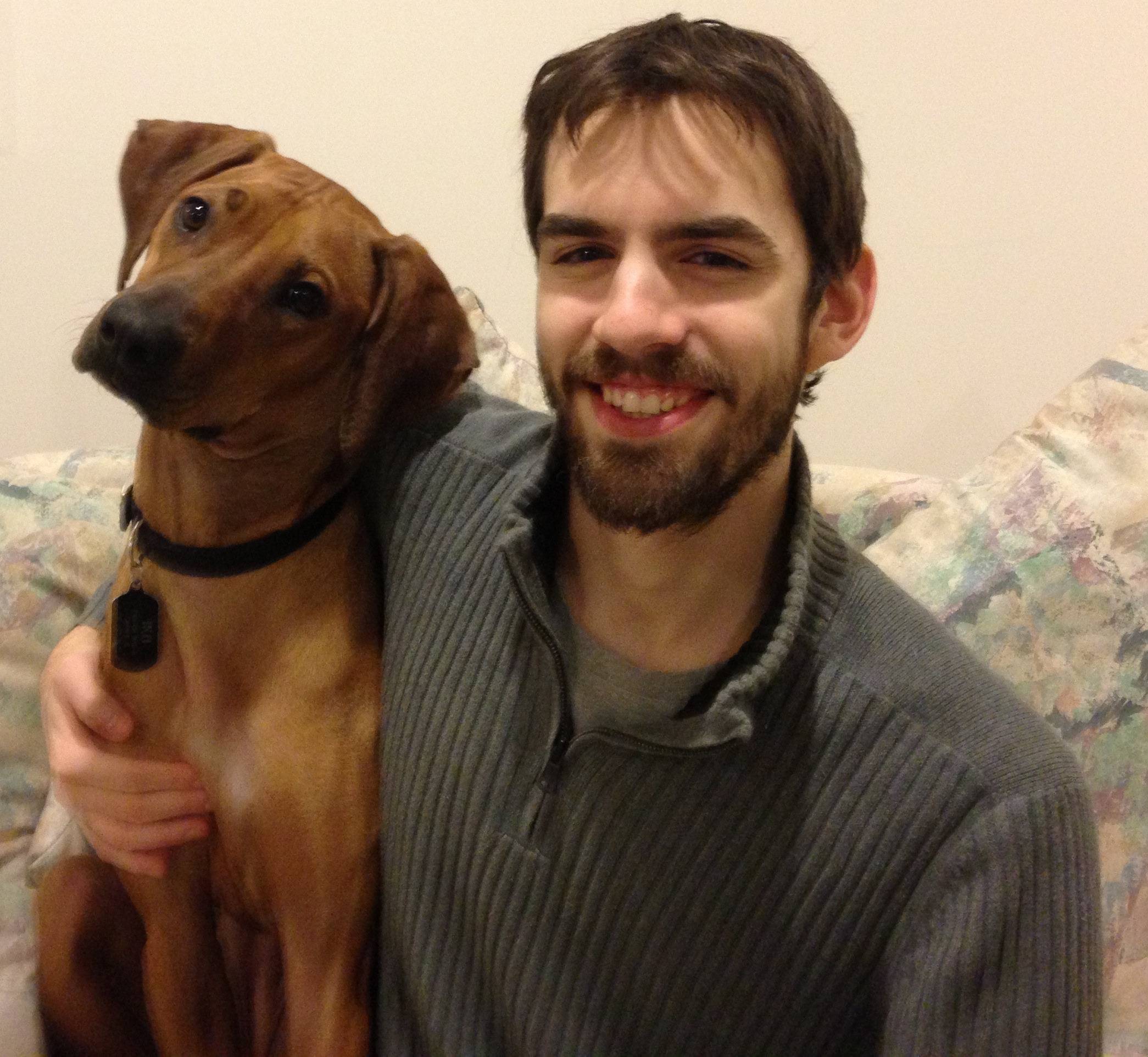 Hello, my name is Nick Sutton. I’m a sophomore majoring in Integrative Biology and aiming for a minor in Spatial and Quantitative Methods in Natural Resources and Environmental Sciences. As one of the biologists of the group, I’m working a lot with Shannon and Becky to help ensure the functionality of our mathematical model in order to keep it as realistic as possible. Once the summer hits, I’ll be helping in the design and implementation of the many behavioral assays we will be performing in order to test our model. This project is very exciting for me since I’m getting to experience a lot of visual ecology and mathematical programming at a deeper level than I would have thought possible as an undergrad. Though exciting, the project is not without its challenges, and I’d say that, for me, the most difficult aspect of this project is integrating the math and the biology. While I have a firm grasp of each subject separately, things tend to get a bit more complicated when you combine the two. Regardless of these challenges, I’m looking forward to continuing the project and seeing how well the results of our behavioral assays match up with our models.
Hello, my name is Nick Sutton. I’m a sophomore majoring in Integrative Biology and aiming for a minor in Spatial and Quantitative Methods in Natural Resources and Environmental Sciences. As one of the biologists of the group, I’m working a lot with Shannon and Becky to help ensure the functionality of our mathematical model in order to keep it as realistic as possible. Once the summer hits, I’ll be helping in the design and implementation of the many behavioral assays we will be performing in order to test our model. This project is very exciting for me since I’m getting to experience a lot of visual ecology and mathematical programming at a deeper level than I would have thought possible as an undergrad. Though exciting, the project is not without its challenges, and I’d say that, for me, the most difficult aspect of this project is integrating the math and the biology. While I have a firm grasp of each subject separately, things tend to get a bit more complicated when you combine the two. Regardless of these challenges, I’m looking forward to continuing the project and seeing how well the results of our behavioral assays match up with our models.
Ecology of Infectious Disease
Sarah Duple (Integrative Biology Honors), Glynn Davis (Mathematics),Ping Lee (Integrative Biology), Dr. Carla Cáceres (Animal Biology), Dr. Zoi Rapti (Mathematics)
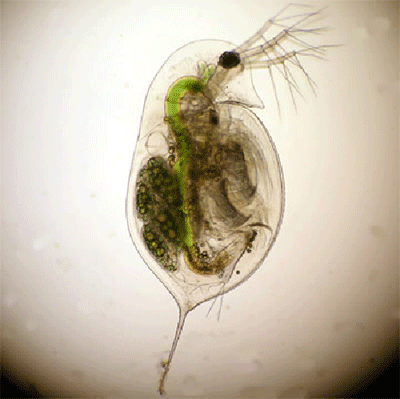 The 2013 BioMath Daphnia Disease team consists of three members, Sarah Duple- junior in Integrative Biology Honors, Ping Lee- senior in Integrative Biology, and Glynn Davis- sophomore in Mathematics. When we first arrived at the University of Illinois Urbana-Champaign as freshmen, we had no idea what we wanted to do for the next four years. Luckily, the U of I offers many courses that help students explore their interests in many different majors and fields. We all made a great decision and signed up for one of these courses, IB/Math 299 (Biomath), and it was the turning point of our college careers.
The 2013 BioMath Daphnia Disease team consists of three members, Sarah Duple- junior in Integrative Biology Honors, Ping Lee- senior in Integrative Biology, and Glynn Davis- sophomore in Mathematics. When we first arrived at the University of Illinois Urbana-Champaign as freshmen, we had no idea what we wanted to do for the next four years. Luckily, the U of I offers many courses that help students explore their interests in many different majors and fields. We all made a great decision and signed up for one of these courses, IB/Math 299 (Biomath), and it was the turning point of our college careers.
Throughout the course, we learned and explored the field of biomathematics and developed several research topics related to the ecology of infectious diseases. In 2012 (together with past team-member Adam Koss), we all worked together to study the dilution effect. The dilution effect is a concept in disease research by which biodiversity can potentially reduce disease prevalence. We specifically studied how disease dynamics change between a species of Daphnia, D. dentifera and its fungal pathogen Metschnikowia when a competitor species of D. dentifera, D. pulicaria is added to the system. We modeled the disease system using an ordinary differential equations system and also conducted biological experiments in the lab to obtain data to support our model predictions.
This year, the three of us are continuing to work with the Daphnia project but each focusing on different aspects of the system. Glynn is currently working on a three population mathematical model to determine how different parameters that are associated with negative fitness costs, such as feeding rate reduction, fecundity reduction, and per-spore infectivity affect virulence. Ping is also looking into the per-spore infectivity parameter, but specifically at how successful the spores are at transmitting the disease to different host genotypes, and how that affects the disease prevalence in the host population. Sarah is focusing on how different resource acquisition traits in the host and its competitors affect disease prevalence on different resource qualities.
In the coming months, we will all be working individually and collectively along with our advisors Dr. Carla Cáceres from Department of Animal Biology and Dr. Zoi Rapti from the Department of Mathematics. At the end of the summer we will be presenting our research at the 98th annual Ecological Society of America conference!

